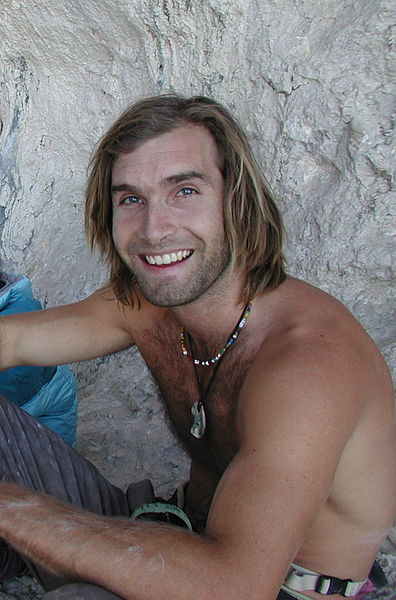Chris Omprakash Sharma is an American rock climber who is considered one of the greatest and most influential climbers in the history of the sport. He dominated sport climbing for the decade after his 2001 ascent of Realization/Biographie, the world's first-ever redpoint of a consensus 9a+ (5.15a) graded route, and ushered in what was called a "technical evolution" in the sport. Sharma carried the mantle of "world's strongest sport climber" from Wolfgang Güllich, and passed it to Adam Ondra.
Sharma in 2008
Es Pontàs, Mallorca. Sharma's route climbs the roof of the sea arch finishing at its apex.
In the history of rock climbing, the three main sub-disciplines—bouldering, single-pitch climbing, and big wall climbing—can trace their origins to late 19th-century Europe. Bouldering started in Fontainebleau, and was advanced by Pierre Allain in the 1930s, and John Gill in the 1950s. Big wall climbing started in the Dolomites, and was spread across the Alps in the 1930s by climbers such as Emilio Comici and Riccardo Cassin, and in the 1950s by Walter Bonatti, before reaching Yosemite where it was led in the 1950s to 1970s by climbers such as Royal Robbins. Single-pitch climbing started pre-1900 in both the Lake District and in Saxony, and by the late-1970s had spread widely with climbers such as Ron Fawcett (Britain), Bernd Arnold (Germany), Patrick Berhault (France), Ron Kauk and John Bachar (USA).
The forest of Fontainebleau, the birthplace of bouldering at the turn of the 20th-century.
Falkenstein, in Saxon Switzerland where routes above grade 6a (5.10a) were first climbed in 1906.
Vajolet Towers, Dolomites; Torre Winkler, named after Georg Winkler, is the largest tower (centre); and was the start of early big wall climbing
Oliver Perry-Smith (right) freed the first 6a (5.10a) with Perrykante in 1906 in the Saxon Switzerland; a region where the world's first 6a/a+ (Südriss, 1910), 6a+ (Westkante, 1918), 6a+/b (Kuniskante, 1921), 6b (Rostkante, 1922), and 6b+ (Talseite, 1952) would also be freed.






